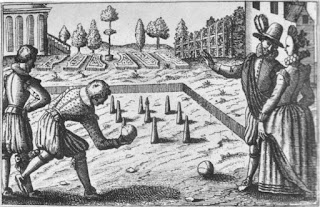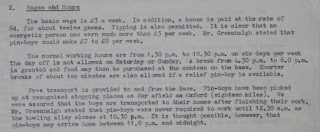
Skittles or nine pins is a traditional game played in English pubs and involves players taking turns to throw wooden balls down a lane in an attempt to knock over nine wooden skittles at the end of the lane. It is the fore-runner of the relatively modern game of ten pin bowling. The game differs from lawn bowls, in which the aim is to bring the ball to rest near a stationary ball called a jack.
Early sixteenth century woodcut
3200 BC, Egypt - In the 1930’s British anthropologist, Sir Flinders Petrie, discovered a collection of objects in a child's grave that appeared to him to be used for a crude form of bowling.
3rd or 4th century AD, Germany - Church parishioners played a game with a club or Kegel (said to represent the Heide ‘heathen’). A stone was rolled at the Heide, and those successfully toppling it were believed to have cleansed themselves of sin.
1366 - Edward III banned his troops from
playing the game so that they would not be distracted from their archery
practice.
1455 - The roofing over of lanes in London for lawn bowls was the beginning of bowling as an all-weather game.
1477 - Edward IV issued an edict against "bowles, closh, kayles, hand-in and hand-out" for similar reasons given in 1366. The game of kayles involved knocking down pins with a stick instead of a ball.
July 18, 1588 – Sir Francis Drake was playing a game of skittles as the Spanish Armada approached in the English Channel. When informed, Drake continued to play saying, "We still have time to finish the game and to thrash the Spaniards, too." He lost the game, but won the war.
1824
- The extent of the popularity of bowls
and bowling can be demonstrated by the number of street names in London in the
early nineteenth century with a bowling reference.
James Pigot & Co.'s, Metropolitan Guide & Book
of Reference to Every Street ... and Public Building in the Cities of London
& Westminster:
Bowl
Yard, Brownlow Street, Drury Lane
Bowling
Alley, Thames Street
Bowling
Alley, Tooley Street
Bowling
Green, 49 King Street, Boro
Bowling
Green, Lisson Green
Bowling
Green Lane, 44 Coppice Row, Clerkenwell
Bowling
Green Lane, 27 High Street, Marylebone
Bowling
Green Row, Haberdasher’s Walk, Hoxton
Bowling
Pin Alley, Bream’s Buildings [Chancery Lane]
Bowling
Street, Dean’s Yard, Westminster
Bowling
Street, 10 Turnmill Street, Clerkenwell
Playing skittles was often
associated with anti-social behaviour, perhaps because of its connection with
inns and public houses.
1828 – John Griffiths, aged 18, a carpenter, convicted at the Old Bailey in
May 1828 of larceny against his parents. Sentence: 7 years transportation.
 TNA HO 17/45/61 -
TNA HO 17/45/61 -“[John Griffiths] who always conducted himself
properly, and attended his employment, until
about the month of April 1827, when he became
in the habit of visiting skittle grounds, and other
similar places, and whence he became acquainted with persons of bad character…”
1841 Connecticut, USA - Nine pin bowling was banned in that State due to its association in gambling and crime. It is said that at this point that another pin was added so that the game could continue, creating the game of ten-pin bowling.
Gambling
on games of skittles was not confined to the USA as records found in The
National Archives demonstrates.
30 April 1846, Manchester - MH 12/9361/278, Folios 440-443. Letter from
Robert Weale, Assistant Poor Law Commissioner, to the Poor Law Commission,
including the deposition of John Tomlinson, regarding the unsuitability of
Jeremiah Burrows, Publican, to be Collector of rates for Sutton on Ashfield.
“On the several
occasions that I visited the Peacock Inn kept by Mr Burrows I observed persons
playing in the ground adjoining the house at the games of shoes [a form of
quoits] and nine-pins. I heard the person who were playing betting on the games
and the stakes they placed for was ale.”
20 September 1852 – TNA PCOM 3/40/4299, Samuel Ridgeley was convicted of unlawfully
obtaining a large sum of money by fraud and unlawful device and ill-practice in
wagering on the event of a certain game called skittles at the Central Criminal
Court at London, Middlesex.
Sentence:
7 years' transportation.
1853 - TNA ADM
101/87/8/4, the medical and surgical
journal of David Lyall, Surgeon on HMS Assistance, records while the ship was employed in
the Arctic Region during the winter of 1853, a skittle alley was
built next to the ship for the entertainment of the crew.
1890 – TNA BT 31/4753/31406 and BT 34/692/31406, Company No: 31406; Turners' Lawn Skittles Company Ltd. Incorporated in 1890 (dissolved before 1916).
1894 – TNA BT 31/5988/42253 and BT 34/1004/42253,
Company No: 42253; Patent Automatic Parlour Skittle Syndicate Ltd. Incorporated
in 1894 (dissolved before 1916).
1938 – TNA BT
31/35735/343726, No. of Company: 343726; The Southbourne Skittle Club Ltd.
Incorporated in 1938 (dissolved in 1950).
The notion of skittle allies being an unsuitable place for young people continued into the 20th century when American airbases began to employ young men as attendants.
1948-1956 – TNA LAB 19/498, Undesirable vacancies: employment of juveniles in amusement parks, fun fairs, etc and "pin-boys" and "skittle alley" attendants in United States Army Air Base at
Bentwater, East Anglia.
2. Wages and Hours
(para 2)
The normal working hours are from 1.30 p.m. to 10.30 p.m. on six days per week. The day off is not allowed on Saturday or Sunday....

7. Conclusions
(a) This is an unskilled and unprogessive job.
1960 – TNA COAL 80/2015/3 - Photograph depicting: ten-pin bowling. Groups of young people play in a three lane alley.
Nothing to do with the game of bowling but I found this entry from 1708 quite amusing:
TNA PROB 18/30/53 Probate
lawsuit Bowling v Ball, concerning the deceased Jane Bowling, spinster of St
Bride, London.
Other
Sources:
The Bowling Museum -- http://www.bowlingmuseum.com/history.asp
Online Guide to Traditional Games
-- http://www.tradgames.org.uk/games/Bowls.htm





